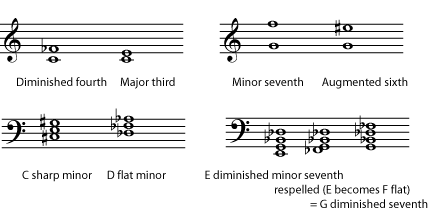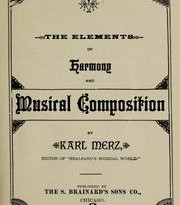Enharmonic spellings and music notation
An explanation of notes, chords, keys, and scales that are written differently but sound the same.
Enharmonic Notes
In modern music, an enharmonic is a note (or key signature) which is the equivalent of some other note (or key signature), but spelled differently. For example, in twelve-tone equal temperament (the modern system of musical tuning in the west), the notes C# (C sharp) and Db (D flat) are enharmonically equivalent – that is, they are represented by the same key (on a musical keyboard, for example), and thus are identical in pitch, although they have different names and diatonic functionality.
In common notation, a note can be sharp, flat, or natural. A sharp symbol raises the pitch (of a natural note) by one half step; a flat symbol lowers it by one half step.
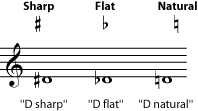
Why do we bother with these symbols? There are twelve pitches that are available. We could give each of those twelve pitches its own name (A, B, C, D, E, F, G, H, I, J, K, and L) and its own line or space on a staff. But that would actually be fairly inefficient, because most music is in a particular key. And music that is in a major or minor key will tend to use only seven of those twelve notes. So music is easier to read if it has only lines, spaces, and notes for the seven pitches it is (mostly) going to use, plus a way to write the occasional notes that are not in the key. This is basically what common notation does. There are only seven note names (A, B, C, D, E, F, G), and each line or space on a staff will correspond with one of those note names. We get the twelve pitches by saying that any of these notes can be sharp, flat, or natural. Look at the notes on a keyboard.
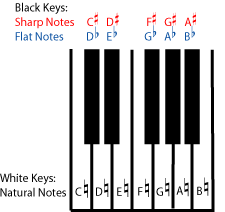
Because most of the natural notes are two half steps apart, there are plenty of pitches that you can only get by naming them with either a flat or a sharp (on the keyboard, the “black key” notes). For example, the note in between D natural and E natural can be named either D sharp or E flat. These two names look very different on the staff, but they are going to sound exactly the same, since you play both of them by pressing the same black key on the piano.

This is an example of enharmonic spelling. Two notes are enharmonic if they sound the same on a piano but are named and written differently.
C sharp and D flat F sharp and G flat G sharp and A flat A sharp and B flat

But these are not the only possible enharmonic notes. Any note can be flat or sharp, so you can have, for example, an E sharp. Looking at the keyboard and remembering that the definition of sharp is “one half step higher than natural”, you can see that an E sharp must sound the same as an F natural. Why would you choose to call the note E sharp instead of F natural? Even though they sound the same, E sharp and F natural, as they are actually used in music, are different notes. (They may, in some circumstances, also sound different; see below.) Not only will they look different when written on a staff, but they will have different functions within a key and different relationships with the other notes of a piece of music. So a composer may very well prefer to write an E sharp, because that makes the note’s place in the harmonies of a piece more clear to the performer. In fact, this need to make a note’s place in the harmony clear is so important that double sharps and double flats have been invented to help do this. A double sharp is two half steps (one whole step) higher than the natural note. A double flat is two half steps lower than the natural note. Double sharps and flats are fairly rare, and triple and quadruple flats even rarer, but all are allowed.
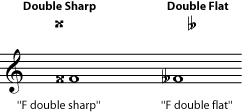
E natural B natural C natural G natural A natural
F flat; D double sharp C flat; A double sharp B sharp; D double flat F double sharp; A double flat G double sharp; B double flat
Enharmonic Keys and Scales
In a given diatonic scale, an individual note name may only occur once. In the key of F for example, the major scale is: ‘F, G, A, Bb, C, D, E, (F)’. Thus, the ‘Bb’ is called ‘Bb’ rather than ‘A#’ as we already have a note named ‘A’ in the scale. The scale of F# major is: ‘F#, G#, A#, B, C#, D#, E#, (F#)’; thus we use the term ‘A#’ instead of ‘Bb’ as we need the name ‘B’ to represent the ‘B’ note in the scale, and ‘E#’ instead of ‘F’ as we need the name ‘F’ to represent the ‘F#’ note in the scale.
Keys and scales can also be enharmonic. Major keys, for example, always follow the same pattern of half steps and whole steps. (See Major Keys and Scales. Minor keys also all follow the same pattern, different from the major scale pattern; see Minor Keys.) So whether you start a major scale on an E flat, or start it on a D sharp, you will be following the same pattern, playing the same piano keys as you go up the scale. But the notes of the two scales will have different names, the scales will look very different when written, and musicians may think of them as being different. For example, most instrumentalists would find it easier to play in E flat than in D sharp. In some cases, an E flat major scale may even sound slightly different from a D sharp major scale. (See below.)
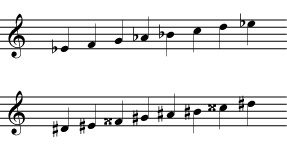
The E flat major and D sharp major scales sound the same on the piano, although they look very different. If this surprises you, look again at the piano keyboard in the figure above and find the notes that you would play for each scale.
Since the scales are the same, D sharp major and E flat major are also enharmonic keys. Again, their key signatures will look very different, but music in D sharp will not be any higher or lower than music in E flat. Enharmonic Keys
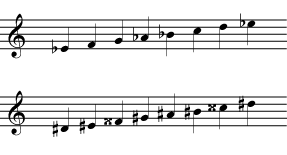
- All key signatures also have an infinite number of enharmonic key signatures that sound the same. The most common interchanges occur above 4 sharps/flats, though. For example, the key of B, with five sharps, is enharmonically equivalent to the key of Cb, with 7 flats. Interestingly enough, though, keys past 7 sharps/flats exist; they are, however, normally impractical. The key of Ab, with four flats, is equivalent to the key of G#, with 7 sharps, the first of which being double-sharped (order of sharps: F## C# G# D# A# E# B#).
The key signatures for E flat and D sharp look very different, but would sound the same on a keyboard.
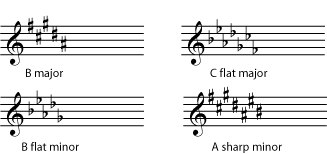
Enharmonic Spellings and Equal Temperament
- In ancient Greek music, the enharmonic scale was a form of octave tuning, in which the first, second, and third notes in the octave were separated approximately by quarter tones, as were the fifth, sixth, and seventh.
All of the above discussion assumes that all notes are tuned in equal temperament. Equal temperament is the only tuning system that really works for instruments that are expected to play in any major or minor key and that cannot retune whenever they change keys. This includes bells, xylophones, and pipe organs as well as pianos. Because of this, equal temperament is a sort of “official” tuning system for Western music. But voices and instruments that can fine-tune quickly (for example violins, clarinets, and trombones) often move away from equal temperament. They sometimes drift, consciously or unconsciously, towards just intonation, which is more closely based on the harmonic series. When this happens, enharmonically spelled notes, scales, intervals, and chords, may not only be theoretically different. They may also actually be slightly different pitches. The differences between, say, a D sharp and an E flat, when this happens, are very small, but may be large enough to be noticeable. Many Non-western music traditions also do not use equal temperament. Sharps and flats used to notate music in these traditions should not be assumed to mean a change in pitch equal to an equal-temperament half-step. For definitions and discussions of equal temperament, just intonation, and other tuning systems, please see Tuning Systems.
Enharmonic Intervals and Chords
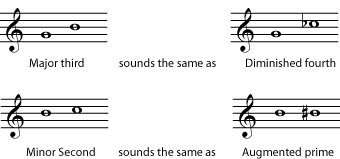
Chords and intervals also can have enharmonic spellings. Again, it is important to name a chord or interval as it has been spelled, in order to understand how it fits into the rest of the music. A C sharp major chord means something different in the key of D than a D flat major chord does. And an interval of a diminished fourth means something different than an interval of a major third, even though they would be played using the same keys on a piano. (For practice naming intervals correctly, see Interval. For practice naming chords correctly, see Naming Triads.)
